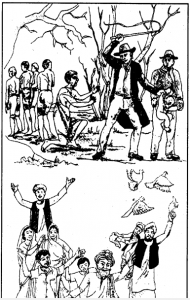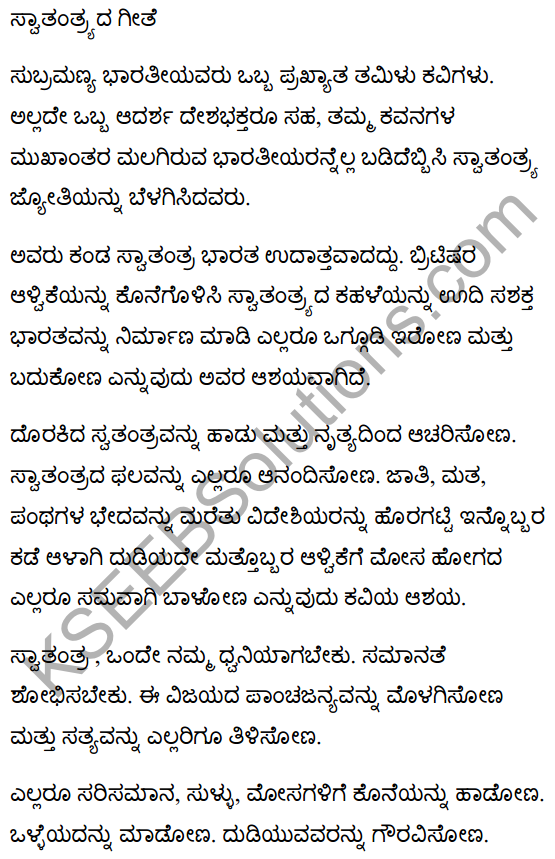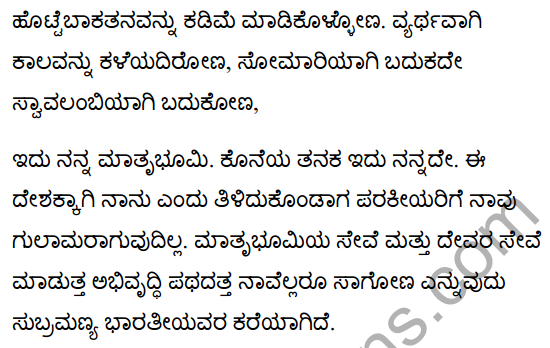By understanding the academic needs we have prepared the Karnataka State Board English Class 9 Solutions Chapter Wise. Our aim is to help the students by providing the question and answers chapter wise and help them to gain a good score in the exams. Before you start your preparation go through the chapters covered in this academic. So go through them and Download KSEEB Solutions for Class 9 English Poem Chapter 7 The Song of Freedom Question and Answers Pdf for free.
The Song of Freedom Poem Questions and Answers, Notes, Summary
The topics covered in Karnataka Secondary Education Examination Board Class 9 Solutions for English Chapter 7 The Song of Freedom. The KSEEB Solutions Class 9 English Solutions Chapter 7 The Song of Freedom Question and Answers are prepared according to the latest edition.The Chapterwise page will help the students to revise the syllabus during the exams.
Before you read:
Question 1.
Look at the picture below. What do they suggest? Share your responses in groups or pairs.

Answer:
The picture of British Officers punishing the people. They are beating the people who fight for freedom.
The other picture is joyout people are free. They are enjoying full freedom.
Question 2.
Read the following poem. What is its theme? What message does it convey? As you read and reread you will draw some meanings from it. Try to share your thoughts and feelings with others in your group.
Answer:
What is its there?
The poem is about the inspiration to fight for freedom. It is about spreading the message of peace and harmony. People should have universal concept. Live and Let others live. The pair and agony should disapear. The poem expresses the Indian glory, culture and heritage the people are the flowers of India and blooming all the way spreading our glorious tradition and culture across the globe.
Understand the poem:
Question 1.
Fill in the blanks with the words given in brackets to make it more meaningful:
Answer:
In this poem, the poet celebrates the freedom of our nation. It is celebrated with songs and dance Indians fought for the freedom unitedly leaving no chance to anyone. We are free from the tricks any trickster could play to divide us.
(No chance, freedom, trickster, dance)
Question 2.
This poem celebrates India’s freedom from the British rule:
a) Quote the lines that refer to freedom.
b) What, according to the poet, is freedom?
c) How does he want to celebrate it?
Answers:
a) This is the hour of song and dance, for blissful freedom.
b) It is our universal speech.
c) He wants to blow the conch of victory and publish the truth to all. He wants to celebrate with song and dance.
Question 3.
What does the poet mean by ‘the universal speech’ and ‘experienced grace’?
Answer:
People should unite and only speak about our freedom. We should all be equal so that there is no chance for any animosity.
Question 4.
This poem is not just a description of free India. It is also a description of a glorious India. Do you agree with the statement? If so which are the undesirable elements that the poet desires to free ourselves from?
Answer:
The poem is certainly about glorious India. The poet wants to see caste free India. We should put an end to subservience. We should go for equality. We should be away from lie and deceit.
Question 5.
What difference do you see between ‘the India’ visualised by the poet and the present one?
Answer:
We notice a lot of changes. The ideals are thrown out there is unrest and animosity. People have no peace of mind. In spite of this, we notice something good going on in some book and corner of the country. We should be upheld and practice the ideals of the great leaders.
Read and appreciate.
Question 1.
What images or pictures can you visualise when you read the following lines? You can draw or mime or dramatize the action suggested in these lines.
a) This is the hour of song and dance.
b) We’ll blow the conch of victory.
c) Now lie and deceit are dead.
d) Honour to the ploughman and the workers.
Answers:
a) picture of a dance.
b) We can go for mime.
c) We can dramatic it.
d) We can show this with Qu……….
Question 2.
Look at stanza two. Which words are repeated? What effect does this repetition have on the reader?
Answer:
The words ‘gone’ is repeated. It is used for emphasis.
The Song of Freedom Additional Questions and Answers
Choose the correct answer.
Question 1.
In this poem, the Poet celebrates the _______ of our nation.
(a) festival
(b) game
(c) freedom
(d) culture
Answer:
(c) freedom.
Question 2.
Poet says that we would blow:
(a) The conch of victory
(b) The trumpet
(c) The wind
(d) Flute
Answer:
(a) The conch of victory.
Answer the following questions.
Question 1.
Who is the author of the peom ‘The song of freedom’?
Answer:
C. Subramanya Bharathi is the author of the poem ‘The song of Freedom’. He was a Tamil Poet, a great patriot and an idealist.
Question 2.
What does the poet say about the glutton and rake?
Answer:
There is no place for glutton and rake in Free India. It is a shame to them.
Give one word for the following:
Question 1.
The shell of a sea animal which produces a sound when you blow into it.
Answer:
Conch.
Question 2.
One who behaves in an immoral way, gambling, drinking etc.
Answer:
Rake.
The Song of Freedom Poem Summary in English
This poem is hot just a description of free India. It is also a description of a glorious India. The poet visualises free India.
In this poem, the poet celebrates the freedom of our Nation. It is celebrated with songs and dance Indians fought for the freedom unitedly leaving aside any caste born pride. Now we are no longer subservient to anyone. We are free from the tricks any foreigner could play to divide us. So the poet celebrates India’s freedom from the British rule.
Subramanya Bharathi used the verse as his medium to awaken the slumbering people of India. He is a well known Tamil poet who inspired the masses to overthrow the foreign rule and breath the free air.
The hour of freedom is the song and dance. All rejoice because of attaining freedom. People are free from caste-born pride and we are not ruled by the foreigners. We have put an end to passive subservience. Nobody can fool us (as some did in the past) we are free and have strength. So we sing and dance.
Now we have to enjoy the fruits of freedom. We are all equal’ now there is no animosity because there is equality. We will blow the conch of victory and declare that we are free from the foreigners rule.
We don’t mislead people Lie and deceit are dead. They are no more is existence Ruin has seized the wicked and the good are rewarded.
Let us honour the peasant group. Let us respect the formers we shall put an end to greed. Let us not cross our need’. Let us be needy but not greedy. We shall put an end to immoral ways. Let us be strong, protecting our health. Let us not fall. Prey to wicked pleasures like gambling and drinking. The poet gives a call to believe the great saying that work is worship.
He pleads the masses to inculcate patriotic spirit and slavery. We should live united so that no nation can enslave us. We will certainly prosper and serve the Almighty. Let us widen our thought and action then only we can enjoy the heaven of freedom.
The Song of Freedom Poem Summary in Kannada


We hope the information prevailed in this article is helpful for all the students of Class 9. The Karnataka State Board Solutions for Class 9 English Chapter 7 The Song of Freedom Question and Answers pdf enhance your skills and score good marks in the exams. Stay tuned to get the latest information about the KSEEB Solutions Class 9 English Solutions.